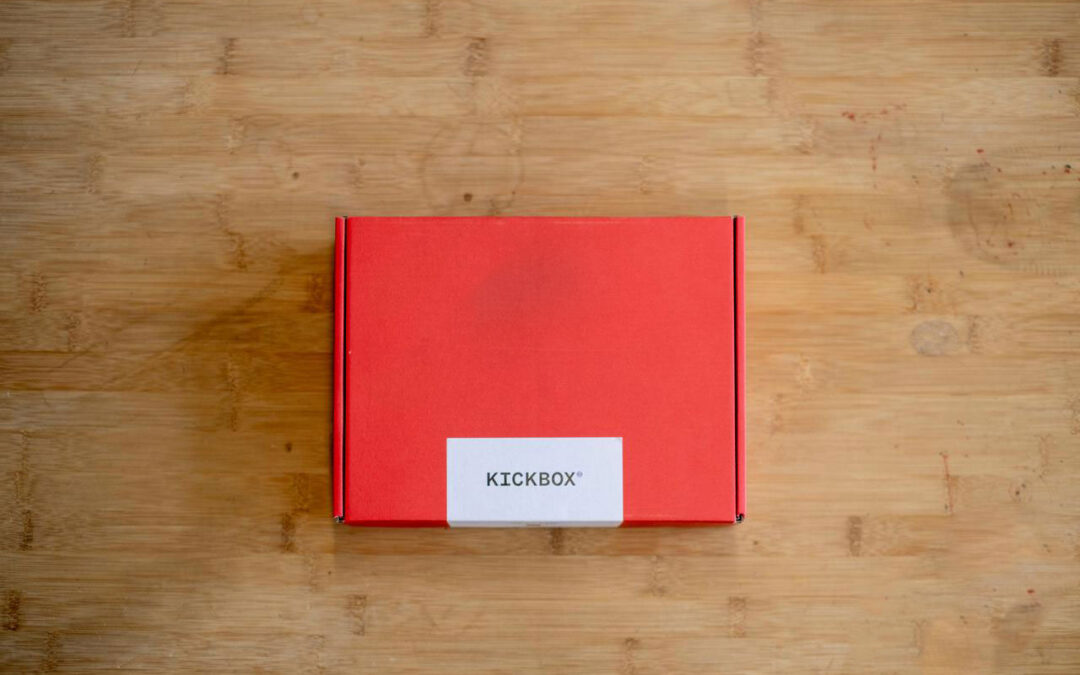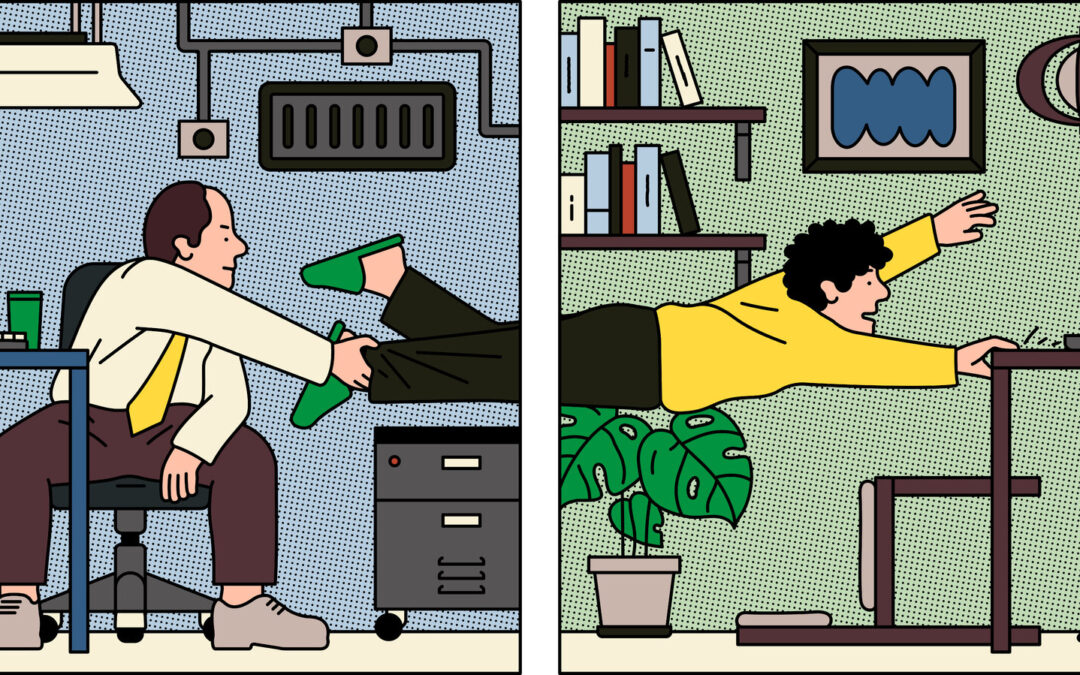
by Robyn Bolton | Dec 10, 2023 | Innovation, Leadership, Stories & Examples
In September 2006, I moved to Copenhagen, Denmark, on a temporary assignment with BCG. As one does when arriving somewhere for an extended period, I went to the grocery store to stock my kitchen.
Since the grocery store was on the ground floor of my building, I bought enough food for a few breakfasts and dinners, made note of the other offerings for future trips, and learned through painful public embarrassment that one must purchase grocery bags (and those bags are nowhere near the checkout lane).
The following day, yogurt was on the menu, and I grabbed the first of the three options I had bought the previous day – a small container of strawberry yogurt.
My heart sank when I peeled off the top.
Instead of super healthy, organic, natural (I’m in Scandinavia, for crying out loud!) yogurt, the stuff in my cup was a rather suspicious beige with dark brown flecks.
Stifling my instinct to dry heave, I chucked the cup into the garbage, along with the five other cups in the clearly spoiled pack, and pulled Brand #2 out of the refrigerator. Surely, this strawberry yogurt would be safe to eat.
But it, too, was beige. A lighter beiger and without the disturbing brown flecks. But still beige.
“You’ve got to be kidding me,” I muttered. Admittedly, the grocery store was more of a glorified convenience store, but c’mon, how hard is it to keep track of Sell By dates?
Into the garbage, it went. Out of the refrigerator came Brand #3 (Yes, I take a portfolio approach to innovation AND food purchases)
Closing my eyes and saying a quick prayer to both the grocery and yogurt gods, I peeled open the yogurt. Not beige but a slight hint of pink, just enough to reassure me that it contained strawberries and hadn’t curdled but not so much that I suspected an American-amount of food coloring.
Later that day…
At lunch, my new colleagues asked how I was settling in. I regaled them with my “bumbling American experiencing culture shock in a country where she looks (and is initially treated like) a local” stories.
As we gathered up our dishes and returned to the kitchen, I commented that I was surprised that my local grocery would keep expired products on the shelf. When they echoed my surprise, I told them about the spoiled yogurt and that 2 of the three brands I purchased were bad.
Based on the glances they exchanged, I knew I had another story to add to an already uncomfortably full book.
It turns out that. The “good” yogurt I ate that morning was from the lowest quality brand, one that no self-respecting Dane would consider eating but that is sold to unsuspecting foreigners (Hi, that’s me). The “bad” yogurt was from respected all-natural brands. All yogurt, they explained, falls somewhere in the spectrum from white to beige or even tan. That’s why they print the flavor name and a picture of the fruit on the label.
How often do we make the same mistake?
How often do we reject something because it’s not what we expect to see? Because it’s not what we’re used to?
Maybe not often when it comes to yogurt, but what about other more important things, like:
- Trends
- Technologies
- Ideas
- Business Models
- Startups
- People
And what happens when we don’t have people willing to point out that we’re no longer in a place where our status quo applies?

by Robyn Bolton | Dec 4, 2023 | Innovation, Metrics
“I would argue that it was an innovation success!”
At that moment, I started to deeply empathize with Alice because I felt like I was tumbling down the rabbit hole.
For the previous several minutes, I had been on one of my usual soapboxes – Innovation needs to generate quantifiable, and specifically financial, results; otherwise, it’s theater at best and performative lie at worst. As Alexander Osterwalder says, “ROI is the only thing that matters in innovation.”
That’s when my conversation partner brought up Kickbox.
Way back in 2012, Adobe’s Chief Strategist and VP of Creativity, Mark Randall, packed “everything an employee needs to generate, prototype, and test a new idea” into a little red box to encourage employees to unleash their inner innovator. One thousand Kickboxes were distributed to interested employees in that first year.
In the decade since, Kickbox has been used at thousands of organizations from multi-nationals (3M, Cisco, Caterpillar, MasterCard, Swisscom, P&G, Roche, Implenia, Zurich Insurance) to educational institutions (ETH, UNSW, USC), government agencies (DARPA, United Nations) and non-profits (Peace Corp, Gates Foundation, Kickstart-Innovation, Careum). It is widely regarded as the world’s most “successful” Intrapreneurship program.
But what does “successful” mean?
Widely adopted?
Highly regarded?
The source of:
- New projects (using Kickbox, Swisscom validated 400+ innovation projects in just two years)?
- New revenue?
- Cost savings?
- Higher profit?
Effective at:
- Increasing employee morale?
- Reducing employee turnover?
- Building a culture of innovation?
Something else?
For Kickbox, “success” means increasing employee engagement, creativity, and collaboration.
Let me be clear: this is an AWESOME outcome. Very few programs have even a temporary impact on employee engagement and the organization’s culture of innovation. So, to have a program that makes a measurable and lasting impact is incredible. To have a program that is so effective that other organizations around the world adopt it AND experience similar benefits is almost unbelievable,
But is that enough?
If Kickbox was the ONLY thing Adobe did to encourage innovation, would Kickbox be considered a success?
I don’t think so.
Kickbox was successful because it was part of a holistic approach to innovation. It was part of a portfolio of efforts to encourage employees to be more creative and collaborative and to build and acquire new sources of revenue.
If Kickbox was the only innovation effort Adobe invested in, it would not have lasted even the two years between its 2012 test and 2014 Adobe-wide launch. It would have been like all other hackathons, shark tanks, events, and gimmicks companies use to encourage innovation without thinking about how to carry on after the event.
Speaking of the two years from test to internal launch…
For Kickbox, “success” also means surviving internal scrutiny.
Each Kickbox contained instructions, a pen, two Post-It notepads, two notebooks, a Starbucks gift card, a bar of chocolate, and a $1,000 prepaid gift card that could be spent on anything the employee needed with NO need for approval, justification, or even an expense report.
Think about that for a moment.
The 1,000-box test cost $1M in gift cards PLUS the costs of all the other materials, and that’s before you factor in the costs of design, assembly, and distribution.
If Kickbox was a grassroots effort instead of one championed by the company’s Chief Strategist and VP of Creativity, a highly respected executive who joined Adobe when it acquired the company he led as CEO, would the company have spent $1M+ on the test and an additional two years refining the concept before launching to the rest of the organization?
I don’t think so.
Kickbox was successful because it survived financial scrutiny and organizational skepticism, protected by a senior executive motivated to deliver on a request to teach his skills and approach to innovation to the rest of a giant organization.
“Success” ultimately means money.
After a week of tumbling, I think that I may have reached the bottom of the rabbit hole and a way to reconcile my money-grubbing capitalist view of innovation with my colleague’s extremely true and data-based assertion that success can be something much softer and more intangible.
Yes, and.
Yes, a successful innovation can be something with qualitative benefits, AND those benefits need to translate into quantifiable (financial) benefits, AND it needs a senior executive to shepherd it through the years of scrutiny and skepticism that kill most efforts.
After all, employee engagement, lower turnover, and more ideas have quantifiable and meaningful financial benefits. So, ultimately, it is all about the money.
Or maybe I’m still in Wonderland.
What do you think?

by Robyn Bolton | Nov 28, 2023 | Innovation, Just for Fun, Leadership
“Yes, and….”
You know it. You love it. You may even use it.
The phrase is a core principle of improv that has become the “magic” brainstorming phrase. On stage, it encourages acceptance and collaboration, and in innovation, it quiets the critics (“No, because”), one-uppers (“No, but”), and passive-aggressive show-offs (“Yes, but”).
And there are other core Improv principles that will help you lead your team to innovation success.
You probably know them. You may or may not love them. And you definitely need to use them.
1. Be human
As Alla Weinberg pointed out in our conversation about Psychological Safety, “People are messy.” YOU are a person (I assume), meaning YOU are messy. And that’s ok because guess what? Your boss, team, and even that super annoying person in (fill in the function) are people, meaning they’re messy.
Improv embraces the mess. When someone says the wrong thing, something unexpected happens, or everything goes wrong, the actors don’t stand around, point fingers, and complain. They embrace the opportunity to step into the scene, support their fellow actor, and move things forward. Plus, a Coach Beard says, “Perfection sucks. Perfect is boring.”
2. Connect
Building genuine and authentic relationships is central to building Psychological Safety. It’s also central to great Improv. Consider this example:
If two performers come on stage and only talk about the muffins they are baking, it’s going to be a boring scene. The audience doesn’t care about the muffins! What they really want to know is how these characters feel, especially about each other. Is one character sad because her daughter is about to go off to college, and she will miss spending time with her? Or is the other character fearful because she will have to navigate adulthood without her mom nearby? If the scene doesn’t focus on the relationship, it isn’t going very far. In order to connect well in the scene, improvisers must be attuned to one another.
If all you do as a leader is talk about your calendar, your To-do list, and deadlines, people aren’t going to care about the work. They’ll do the work because that’s what you pay them to do. But they won’t care enough to problem-solve (they’ll ask you for the solution), suggest improvements (they’ll do what you ask), or develop new ideas (they’ll wait for your orders). As a leader, you need to connect to create. That applies to creating solutions, new businesses, and the next generation of leaders.
3. Actively Listen
Active listening isn’t just about nodding your head while someone else speaks. Active listening requires giving full attention to the speaker, letting go of judgment, and understanding their point of view. You don’t have to agree with what they’re saying, but you do have to understand and respond to it.
Actively listening, understanding, and responding are essential to Improv. When an actor does something completely unexpected, their fellow actors can’t ignore it because that will destroy the show. They respond to it and build on it. After all, you shouldn’t say “Yes and” if you don’t know what you’re saying yes to.
4. Pivot
Pivoting is hard. It’s hard to admit something isn’t working, and often harder to figure out what will work while you’re in the middle of doing the thing that doesn’t work. And that’s what Improv actors have to do all the time. You may not notice because it looks easy. But it only looks easy because they practice all the time.
Flexibility, adaptability, and the ability to change quickly are all skills that can be developed. But you must practice. Some people are naturally more comfortable making changes, but everyone can learn skills and tools to recognize when a change in direction is required and quickly sort through the options to find the next best option.
5. Have fun
Improv is hard work, and it’s fun. Innovation is hard work and (it should be) fun. We spend too much time at work and with our colleagues to not have fun, laugh, or enjoy ourselves. Work will never be all rainbows and unicorns, just like not every Improv sketch will be hilarious. But there must be moments of fun, laughter, and joy because you can’t create or innovate when you’re overwhelmed, downtrodden, or burned out.
As Jeff Ash, Director of Westside Improv, explains:
“Play unlocks the creative spirit that we all have. When people lose a creative spirit and get engulfed in whatever they’re doing in their day-to-day lives, I believe it impacts our ability to connect, build relationships, and be in community.”
What are other lessons we can learn from Improv?

by Robyn Bolton | Nov 15, 2023 | Innovation, Leadership, Tips, Tricks, & Tools
or The No-Cost, No-Hug Secret to Smarter Teams
Welcome to the exciting conclusion of “Everything You Ever Wanted to Know About Psychological Safety but Were Afraid to Ask.”
Our generous expert, Alla Weinberg, CEO and Culture designer at Spoke & Wheel, has been patiently leading us beyond and through the buzzy frothiness that we (I) usually associate with Psychological Safety and into the deeply powerful and absolutely essential core elements.
In Part 1, we learned that psychological safety is more neuroscience than psychology (and required to be your smartest self).
In Part 2, we learned the first step to creating safety (and why corporate mandates are antithetical to the goal).
Today, we’re going where we need but don’t want to go – how to create a psychologically safe environment so everyone can thrive.
If Step 1 in creating Psychological Safety is verbalizing your emotions and understanding others’ emotions, I’m hoping Step 2 is easier.
Step two is relational intelligence.
There are three intelligences: emotional, relational, and systems
Relational intelligence is about understanding how to connect with different people, being aware when disconnection happens, and then acknowledging and repairing it. That last part is the most important because, without repair, there’s no safety.
Are you saying that saying, “I’m sorry” is essential to building psychological safety? Because I would much rather ignore the issues and move on. Or, better yet, pretend it never happened.
Nice try. But you know as well as I do that people are messy, and when we come together, there’s tension and conflict, and someone will get hurt or make mistakes. It’s normal. It’s okay as long as you know how to recover, repair, and heal.
The issue isn’t the conflict but how we handle it and whether we can repair it. I have a diagram of a relationship, which is a circle of connection, disconnection, and repair. We go around this circle just like breathing is inhaling and exhaling. Relating, connecting, disconnecting, and repairing is what a relationship is.
OK, step 2 is relational intelligence which requires repairing relationships, so how do I do that? Bonus points if I don’t have to admit to being wrong.
Not only do you have to admit that, but you also need to take responsibility for your impact, not just your intentions. Intentions are great, but without action, they don’t mean much.
When apologizing, we tend to try to explain ourselves. For example, we say, “I didn’t say anything in that meeting, and I’m sorry, but that wasn’t my intention, and I wanted to, but I had my own issue.” Instead, we should say, “I didn’t say anything in that meeting, and I’m sorry.”
When you apologize, don’t say “but.” To repair a relationship, you must take responsibility for your actions and their impact. Saying “but” negates all of that.
(head now on the desk because this is a lot to take in): I’m afraid to ask what Step 3 is, but I will practice verbalizing my feelings and ask anyway. What’s Step 3?
You’re doing great. This is a lot, and it’s ok that you feel overwhelmed.
Step 3 is systems intelligence, which focuses on the relationships within an organization that gives rise to its culture. Systems thinking is about understanding how structures, policies, processes, and relationships interact to create a greater whole,
Systems thinking! We’re getting back to left-brained stuff now. I’m feeling better.
Yes, and since connection is core to psychological safety, systems thinking tells us that we must fundamentally rethink how people work together by centering connection.
How do we do that?
We must reinvent, innovate, and rethink how we work together.
Lack of safety leads to power struggles, walls, and departmental rivalries, creating divisions and “othering.”
Hierarchy doesn’t align with connection, but shared leadership does. Hierarchy erodes trust because you need manager approvals, beg for budgets, or are told to prove your worth to get a seat at the table.
Silos are another problem because they lead to turf wars and people making decisions to protect themselves or their team rather than do what’s best for the greater good.
Look, I love challenging the status quo, but you’re suggesting that we burn it all to the ground and start over.
(Laughing) I don’t lead with that. When I work with organizations, I start with meetings.
Most meetings focus on work topics like status, decisions, and updates. But where are the meetings where we discuss emotions, share personal stories, and express hurt feelings? Everything shifts when we center connection.
Isn’t that called therapy?
Organizations value information, right? Emotions are information.
Emotions reside in our bodies, but in many organizations, the focus is on the intellect. It’s as if the head is the only important part, and the body is merely a vessel to transport the head from meeting to meeting.
And that brings us full circle to why psychological safety is mostly neuroscience. Our body houses our nervous system, where we feel safety or the lack thereof. So, when people talk about bringing their whole selves to work, I mean our entire body, not just the intellect. Our bodies contain wisdom and information that we often overlook and undervalue, yet this is where the crucial information resides to create psychological safety.
We don’t think of emotions as information. We think of them as signs of weakness, and you can’t be weak and successful.
It’s a lot of fear because how we’ve worked for the last 50 years gave us an illusion of certainty. Acknowledging that there is no certainty and that we’re in entirely uncharted territory is scary, and there’s a fear that everything will fall apart. We think the business won’t survive if we do it the other way.
I respect that fear. It’s okay to be afraid. But if we acknowledge that all of this comes from fear, we will be open to new ideas or thoughts. For organizations that want to innovate, they must change how they work. You can’t keep doing the same thing and expect different results. You need to innovate your approach to work.
Thank you so much for all of this. You’ve shared so much. Some of it was hard to hear, but I think that’s also a sign that it’s important to hear. Any last words of advice?
Give yourself and others permission to be human beings again. Not robots or cogs, not human resources, but to be human beings. That includes our bodies, our emotions, our messiness, and our relationships with each other.
If you would like to learn more about Alla and her work, please visit her firm’s website, www.spokeandwheel.co, and definitely download a FREE digital copy of her book, A Culture of Safety: Building a Work Environment Where People Can Think, Collaborate, and Innovate

by Robyn Bolton | Nov 7, 2023 | Innovation, Leadership, Tips, Tricks, & Tools
or “Why Mandating a Return to the Office Destroys Safety”
In last week’s episode, we learned that psychological safety is more neuroscience than psychology and the huge role our nervous system plays in our experience of safety.
This week, we’re going deeper into our nervous system and how we can use our understanding of it to influence our psychology.
I’m sensing I can’t think my way to safety. So, can I fix my nervous system to feel safe and smart?
This is where I go beyond Dr. Amy Edmondson’s definition of psychological safety to incorporate neuroscience and how our nervous system works.
Our nervous system has three states:
- Immobilization or the freeze response, as you felt, is often accompanied by a sense of overwhelm
- Fight-and-flight when you try to either end the conversation or become more aggressive, resistant, and push back on exploring other alternatives.
- Rest-and-Digest when you feel safe, social, and connected to the people around you
This third state sets humans and mammals apart from other living things. Communicating and connecting serve as a survival mechanism and represent a safe state for our nervous system. When we communicate and connect, our tribe looks out for us and keeps us safe from threats like lions or unfriendly tribes.
So, the answer is to foster more profound connections among human beings, which requires going well beyond our work roles and activities.
Does it require hugging? I knew it would require hugging.
Don’t worry, hugging isn’t mandatory.
We, as individuals, have a strong desire to connect and communicate, but it doesn’t necessarily require physical proximity. Being physically together doesn’t guarantee anything.
But what about the push to return to the office? There’s even research to support executives’ claims that physical proximity is essential to culture, innovation, and connection.
Not only does physical proximity not guarantee anything, but being forced to return to the office causes more harm than good.
From a safety perspective, our nervous system doesn’t want to feel trapped. Being forced back to the office activates our flight-or-fight response and erodes safety. Because of how our nervous system perceives choices, the more choices people have, the safer they feel.
Even though I’m tempted to ask questions about building psychological safety at the team or company level, I want to stay on the individual level for a moment. We talked about how I wasn’t consciously unsafe during a phone call. How can I tell when I feel unsafe if I’m not conscious of it?
There’s physical science behind what happens when you feel unsafe. Your heart rate increases, you might hold your breath, and your body may tense up. Your thoughts might blank out, and your peripheral vision may narrow as your body prepares for fight or flight. Your body doesn’t differentiate; it treats any threat as a threatening event.
On the other hand, feeling safe doesn’t mean you lack emotions or feel calm. Feeling calm and internally relaxed signifies safety, but it’s more than that. When your nervous system is regulated, your emotions align with the situation. They’re not an extreme overreaction or underreaction. There’s congruence. If your emotional response matches the situation, your nervous system and brain feel safe.
That makes sense, but it’s not easy. We’re trained to hide our emotions and always appear calm. I can’t tell you how many times I’ve heard and said, “Be a duck. Calm on the surface and paddling like hell below it.”
And that is not congruent. But congruence doesn’t mean you act out like a toddler, either.
Step one in creating safety is calming your nervous system by verbalizing your feelings. If you say, “This conversation is overwhelming for me. I need a break. Let me get some water,” you’re safe and regulated at that moment. There’s nothing wrong.
But when you can’t verbalize what you’re experiencing and freeze, that’s a sign you’re no longer in a safe state. Your body starts pumping cortisol and adrenaline, preparing for whatever it perceives as a threat.
Even if you feel overwhelmed, if you’re aware of that feeling and can take some breaths or a short break and return to the conversation, you’re in a safe, regulated state.
I can’t imagine admitting to feeling overwhelmed or asking for a break! Plus, I work with so many people who say, “I feel overwhelmed, but I can’t take a moment for myself. I need to plow through and get this done.”
It takes a tremendous amount of self-awareness. If you want to create safety and emotional intelligence, you must know what you’re feeling and be able to name it. You also need to sense what others are feeling and understand your emotional impact on them.
For example, if you say, “I’m feeling overwhelmed right now,” and I respond calmly and slow my cadence of speech, your nervous system receives the message that everything is okay. However, if I’m in “fight or flight” mode and you’re overwhelmed, we’ll end up in a chaotic and unproductive cycle.
Self-awareness and understanding are essential to safety. Unfortunately, many organizations I speak with need help with this.
Amen, sister,
Stay tuned for next week’s exciting conclusion, 3 Steps to Building a Psychologically Safe Environment or The No-Cost, No-Hug Secret to Smarter Teams

by Robyn Bolton | Nov 2, 2023 | Innovation, Leadership
or Why the Lack of Psychological Safety Makes You Dumber
It’s been over 20 years since “Psychological Safety” exploded onto the scene and into the business lexicon. But as good as it sounded, I always felt like it was one of those “safe space, everyone gets a trophy, special snowflake” things we had to do to make the Millennials (and subsequent generations) happy.
Then I read Alla Weinberg’s book, A Culture of Safety, and realized I was very, very wrong.
It’s not the equivalent of an HR-approved hug and high-five.
It’s the foundation of what we do. Without it, there is no productivity, creativity, or progress.
Needing to know more, I reached out to Alla, who graciously agreed to teach me.
Thanks for speaking with me, Alla. Let’s get right to the point: why should I, or any business leader, care about psychological safety?
The short answer is that without psychological safety, you are dumber. When you feel unsafe, your operating IQ, which you use for daily tasks, drops in half.
Think about all the people you work with or all the people in your company. They’re there because they’re smart, have experience, and demonstrated that they can do the job. But then something goes wrong, and you wonder why they didn’t anticipate it or plan appropriately to avoid it. You start to question their competence when, in fact, it may be that they feel unsafe, so parts of their brain have gone offline. Their operating IQ isn’t operating at 100%.
I am so guilty of this. When things go wrong, I assume someone didn’t know what to do, so they need to be trained, or they did know what to do and decided not to do it. It never occurs to me that there could be something else, something not logical, going on.
We all forget that human beings are biological creatures, and survival is the number one evolutionary trait for all living beings. Our body and mind are wired to ensure our continued existence.
A part of the brain – the prefrontal cortex, responsible for planning, executive thought, and analysis – is unique to humans, and it goes offline when our body feels unsafe.
When we experience extreme stress, our body and mind cannot distinguish an impending deadline from a lunging tiger. Our body and mind prioritize survival, so we experience all the biological responses to a threat, like getting tunnel vision, losing peripheral vision, and perceiving limited options.
So, when you’re trying to meet a deadline, and your manager or supervisor asks why you didn’t consider alternatives or complete a specific task, it’s because you physically couldn’t think of it at that moment. This is how human beings operate.
My first reaction is to wonder who can’t tell the difference between a deadline and a tiger because if you can’t tell the difference between the two, you may have bigger problems. But when you mentioned the inability to perceive options, I immediately thought of something that happened yesterday.
I was on a call with a client, someone I’ve worked with for years and consider a friend, and we were trying to restructure a program to serve their client’s needs better. I didn’t feel under threat…
Consciously. You didn’t consciously feel under threat.
Right, I didn’t feel consciously under threat. But I froze. I absolutely couldn’t think. I put my head in my hands and tried to block out all the light and the noise, and I still couldn’t think of any option other than what we were already doing. My brain came to a screeching halt.
That’s your nervous system, and it’s a huge driver of psychological safety. 80% of the information our brain receives comes from our nervous system. So, while you didn’t consciously feel unsafe, your body felt unsafe and sent a signal to your brain to go into survival mode, and your brain chose to freeze.
But it was a Zoom call. I was sitting alone in my office. I wasn’t unsafe. Why would my nervous system think I was unsafe?
Your nervous system doesn’t think. It perceives and reacts. Let me give you a simple illustration that we’ve all experienced. When you touch something hot, your hand immediately pulls away. You say “ouch” after your hand is away from the heat source. When you felt the hot object, your nervous system entered survival mode and pulled away your hand. Your brain then had to catch up, so you saw “Ow” after the threat was over.
Hold up. We’re talking about psychological safety. What does my nervous system have to do with this?
I define psychological safety as a state of our nervous system with three states: safe, mobilized (fight or flight), and immobilized (freeze response). The tricky part is not psychological but neurobiological. You cannot think your way to safety or unfreeze yourself. The rational mind has no control over this. Mantras and mindsets won’t make you feel safe; it’s a neurobiological process.
That is a plot twist I did not see coming.
Stay tuned for Part 2:
How to Use Your Nervous System to Feel Psychologically Safe,
or “Why Mandating a Return to the Office Destroys Safety”





